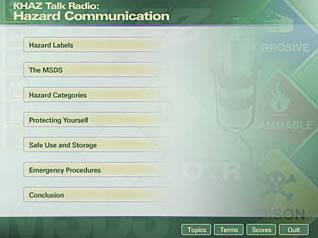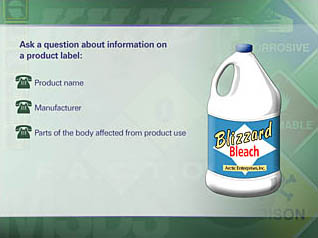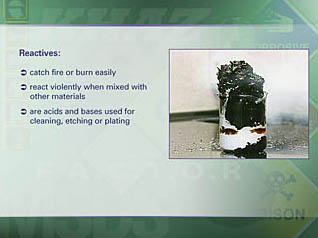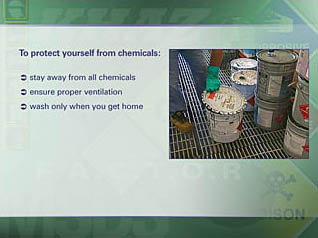HazCom: Hazard Communication: KHAZ Talk Radio

- Product ID
- clmihckr
- Training Time ?
- 56 to 112 minutes
- Language(s)
- English
- Video Format
- Standard Definition
- Required Plugins
- MasteryNet Player
- Lesson Interactions
- 15
- Quiz Questions
- 28
- Closed Captioning



Online Hazcom and Chemical Safety Training
This chemical safety training uses a lively talk radio show format to bring life and entertainment to this important topic. Learners become part of the show as they call in and get answers to their Hazard Communication and chemical safety questions. This chemical safety training prepares the learner to access hazard information from labels and MSDSs, how to work safely with chemicals, how to categorize chemicals and the hazards and controls associated with each category.
![]() This course is in the Advantage™ format, to read about Advantage™ features click here.
This course is in the Advantage™ format, to read about Advantage™ features click here.

- Install on any SCORM LMS
- Rich multimedia presentation with interactions and quiz
- Print certificate and wallet card
- You have 30 days to complete the course
Chemical safety training applies to all workers who work around chemicals or hazardous materials
-
Hazard Labels
- Container labels
- Specific label warnings
- Label colors and numbers
- An unlabeled container
-
The MSDS
- MSDS Basics
- ANSI MSDS: Section 1
- ANSI MSDS: Section 2
- ANSI MSDS: Section 3
- ANSI MSDS: Section 4
- ANSI MSDS: Section 5
- ANSI MSDS: Section 6
- ANSI MSDS: Section 7
- ANSI MSDS: Section 8
- ANSI MSDS: Section 9
- ANSI MSDS: Section 10
- ANSI MSDS: Section 11
- ANSI MSDS: Section 12
- ANSI MSDS: Section 13
- ANSI MSDS: Section 14
- ANSI MSDS: Section 15
- ANSI MSDS: Section 16
-
Hazard Categories
- F.A.C.T.O.R.
- Flammable materials
- Corrosive materials
- Toxic materials
- Reactive materials
-
Protecting Yourself
- Acute and chronic effects
- Routes of entry
- Safe Work Practices
-
Safe Use and Storage
- Flammables
- Corrosives
- Reactives
-
Emergency Procedures
- Clean-up
- Emergency procedure documents
-
Use chemical labels to keep you safe.
- List parts of a chemical label.
- Name 3 words to look for on a label that will alert you of a hazard.
- Differentiate the hazard meanings associated with colors on a label.
- Choose the proper meaning of symbols on a label.
- Explain what to do if a container is not labeled.
-
Properly utilize Material Safety Data Sheets.
- Identify information contained in an MSDS.
- Locate answers to questions regarding a chemical on an MSDS.
-
Identify hazards by category.
- List the four hazard categories [referenced in this course].
- Identify types of substances a category can include.
- Differentiate hazard categories by chemical characteristics.
-
Protect yourself from chemical health hazards.
- Differentiate between acute and chronic health problems.
- Recognize ways a chemical can enter the body.
- Choose ways to eliminate chemicals getting into your body.
- Identify ways to protect your skin and body.
-
Safely use and store hazardous naterials.
- Choose proper procedures to use when working with flammable materials.
- Choose proper procedures to use when working with corrosive materials.
- Choose proper procedures to use when working with reactive materials.
- Agree to always store flammable materials in specially designated storage areas.
- Select the proper storage procedures for corrosive materials.
- Recall the best way to store reactive materials.
-
Follow proper emergency procedures in your workplace.
- Describe the first step to take when a spill occurs
- Recall that companies have documented procedures for handling hazardous materials emergencies.
© Mastery Technologies, Inc.



